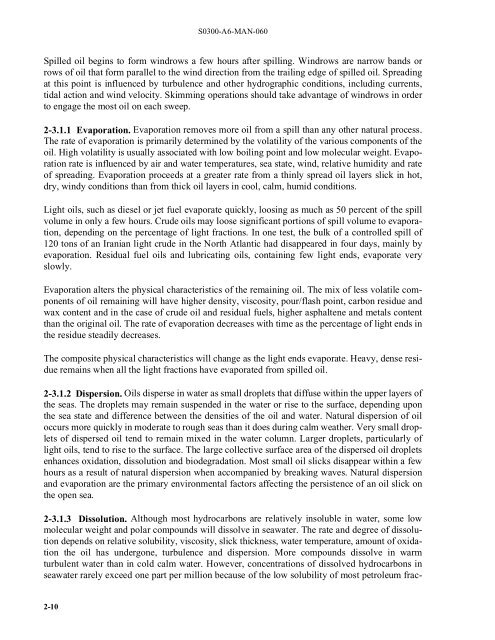U.S. Navy Ship Salvage Manual Volume 6 - Oil Spill Response
U.S. Navy Ship Salvage Manual Volume 6 - Oil Spill Response
U.S. Navy Ship Salvage Manual Volume 6 - Oil Spill Response
- No tags were found...
You also want an ePaper? Increase the reach of your titles
YUMPU automatically turns print PDFs into web optimized ePapers that Google loves.
S0300-A6-MAN-060<strong>Spill</strong>ed oil begins to form windrows a few hours after spilling. Windrows are narrow bands orrows of oil that form parallel to the wind direction from the trailing edge of spilled oil. Spreadingat this point is influenced by turbulence and other hydrographic conditions, including currents,tidal action and wind velocity. Skimming operations should take advantage of windrows in orderto engage the most oil on each sweep.2-3.1.1 Evaporation. Evaporation removes more oil from a spill than any other natural process.The rate of evaporation is primarily determined by the volatility of the various components of theoil. High volatility is usually associated with low boiling point and low molecular weight. Evaporationrate is influenced by air and water temperatures, sea state, wind, relative humidity and rateof spreading. Evaporation proceeds at a greater rate from a thinly spread oil layers slick in hot,dry, windy conditions than from thick oil layers in cool, calm, humid conditions.Light oils, such as diesel or jet fuel evaporate quickly, loosing as much as 50 percent of the spillvolume in only a few hours. Crude oils may loose significant portions of spill volume to evaporation,depending on the percentage of light fractions. In one test, the bulk of a controlled spill of120 tons of an Iranian light crude in the North Atlantic had disappeared in four days, mainly byevaporation. Residual fuel oils and lubricating oils, containing few light ends, evaporate veryslowly.Evaporation alters the physical characteristics of the remaining oil. The mix of less volatile componentsof oil remaining will have higher density, viscosity, pour/flash point, carbon residue andwax content and in the case of crude oil and residual fuels, higher asphaltene and metals contentthan the original oil. The rate of evaporation decreases with time as the percentage of light ends inthe residue steadily decreases.The composite physical characteristics will change as the light ends evaporate. Heavy, dense residueremains when all the light fractions have evaporated from spilled oil.2-3.1.2 Dispersion. <strong>Oil</strong>s disperse in water as small droplets that diffuse within the upper layers ofthe seas. The droplets may remain suspended in the water or rise to the surface, depending uponthe sea state and difference between the densities of the oil and water. Natural dispersion of oiloccurs more quickly in moderate to rough seas than it does during calm weather. Very small dropletsof dispersed oil tend to remain mixed in the water column. Larger droplets, particularly oflight oils, tend to rise to the surface. The large collective surface area of the dispersed oil dropletsenhances oxidation, dissolution and biodegradation. Most small oil slicks disappear within a fewhours as a result of natural dispersion when accompanied by breaking waves. Natural dispersionand evaporation are the primary environmental factors affecting the persistence of an oil slick onthe open sea.2-3.1.3 Dissolution. Although most hydrocarbons are relatively insoluble in water, some lowmolecular weight and polar compounds will dissolve in seawater. The rate and degree of dissolutiondepends on relative solubility, viscosity, slick thickness, water temperature, amount of oxidationthe oil has undergone, turbulence and dispersion. More compounds dissolve in warmturbulent water than in cold calm water. However, concentrations of dissolved hydrocarbons inseawater rarely exceed one part per million because of the low solubility of most petroleum frac-2-10
















